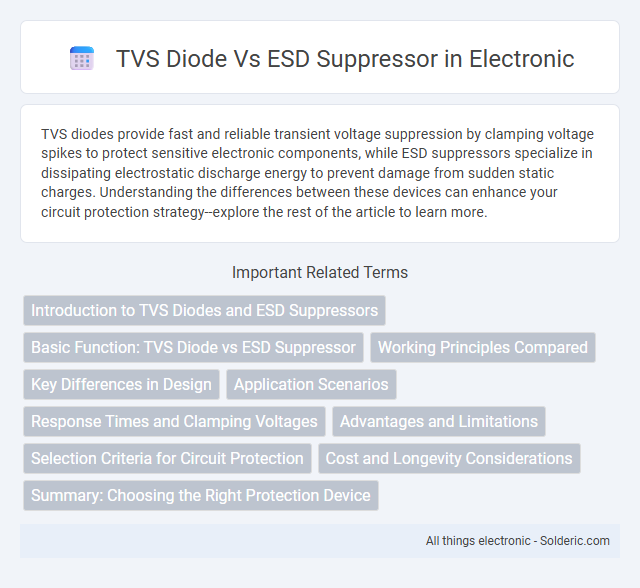TVS diodes provide fast and reliable transient voltage suppression by clamping voltage spikes to protect sensitive electronic components, while ESD suppressors specialize in dissipating electrostatic discharge energy to prevent damage from sudden static charges. Understanding the differences between these devices can enhance your circuit protection strategy--explore the rest of the article to learn more.
Comparison Table
| Feature | TVS Diode | ESD Suppressor |
|---|---|---|
| Purpose | Protects circuits from high-voltage transient spikes | Protects circuits specifically from electrostatic discharge (ESD) |
| Response Time | Nanoseconds, very fast clamping | Sub-nanosecond to nanoseconds, ultra-fast response |
| Clamping Voltage | Relatively low and controlled | Very low clamping voltage, optimized for ESD levels |
| Energy Absorption | High surge current capacity (up to kiloamperes) | Lower energy capacity, designed for ESD pulses |
| Typical Applications | Power supply inputs, automotive, industrial equipment | Integrated circuits, data lines, communication ports |
| Device Type | Semiconductor diode | Polymer or metal-oxide varistor or diode-based suppressor |
| Repetitive Operation | Can handle repetitive transient events | Designed typically for single or few ESD events |
| Form Factor | Surface-mount or through-hole diodes | Usually SMD components with low capacitance |
Introduction to TVS Diodes and ESD Suppressors
TVS diodes are semiconductor devices designed to protect electronic circuits by clamping voltage spikes during transient events, while ESD suppressors are specifically engineered to protect against sudden electrostatic discharges. TVS diodes react rapidly to overvoltage conditions and provide robust clamping, making them effective for high-energy transients like lightning-induced surges. ESD suppressors typically feature low capacitance and fast response times to shield sensitive components from electrostatic discharge without affecting normal circuit operation.
Basic Function: TVS Diode vs ESD Suppressor
TVS diodes protect electronic circuits by clamping voltage spikes instantly during transient events like electrostatic discharge or lightning surges, ensuring voltage remains within safe limits. ESD suppressors primarily guard sensitive components from electrostatic discharge by providing a low-resistance path to ground, rapidly dissipating high-voltage ESD pulses. Both devices safeguard electronics, but TVS diodes handle broader transient voltage protection while ESD suppressors specialize in high-speed ESD event mitigation.
Working Principles Compared
TVS diodes protect circuits by clamping voltage spikes through rapid avalanche breakdown during transient events, effectively shunting excessive current to ground. ESD suppressors absorb and dissipate electrostatic discharge energy using specialized materials that stabilize and neutralize sudden voltage surges. Your choice depends on whether you need fast, high-energy transient voltage clamping (TVS diode) or targeted protection against ESD pulses (ESD suppressor) for sensitive electronic components.
Key Differences in Design
TVS diodes are designed to respond instantly to voltage spikes by clamping high transient voltages and diverting excess current, making them ideal for fast, high-energy surge protection. ESD suppressors, often composed of multilayer components or polymeric materials, are optimized to dissipate electrostatic discharge pulses by providing a low-capacitance path to ground, protecting sensitive electronic circuits. Your choice depends on whether you need robust surge protection with rapid response (TVS diode) or specialized defense against electrostatic discharges (ESD suppressor).
Application Scenarios
TVS diodes are primarily used for protecting sensitive electronic circuits from high-voltage transients caused by lightning strikes, inductive load switching, and automotive surges. ESD suppressors are designed to safeguard devices against electrostatic discharge events in consumer electronics, communication equipment, and semiconductor manufacturing environments. While TVS diodes handle high-energy, short-duration voltage spikes, ESD suppressors focus on low-energy, fast transient discharges to prevent damage to integrated circuits and connectors.
Response Times and Clamping Voltages
TVS diodes typically offer faster response times, often in the picosecond to nanosecond range, making them highly effective for protecting sensitive electronics against transient voltage spikes. ESD suppressors generally provide slightly slower response times but excel in achieving lower clamping voltages, which minimizes stress on components during electrostatic discharge events. The choice between TVS diodes and ESD suppressors depends on balancing the required response speed and acceptable clamping voltage levels to optimize circuit protection.
Advantages and Limitations
TVS diodes provide fast response times and high energy absorption, making them ideal for protecting sensitive electronics against transient voltage spikes. ESD suppressors excel in handling high-frequency electrostatic discharges with lower capacitance, suitable for delicate signal lines. However, TVS diodes can introduce higher capacitance and leakage current, while ESD suppressors may have limited energy dissipation capability in high-voltage surges.
Selection Criteria for Circuit Protection
Selection criteria for circuit protection between TVS diodes and ESD suppressors depend on the specific voltage and energy requirements of the application. TVS diodes offer fast response times and high surge current handling capabilities, making them ideal for protecting sensitive components against transient voltage spikes. ESD suppressors excel in clamping electrostatic discharge pulses with low capacitance, ensuring signal integrity in high-speed data lines and sensitive electronics.
Cost and Longevity Considerations
TVS diodes generally offer a lower initial cost compared to ESD suppressors, making them a cost-effective choice for transient voltage protection in budget-sensitive applications. ESD suppressors, while potentially more expensive upfront, typically provide superior longevity and reliability in high-frequency or repeated discharge environments due to their robust material composition and faster response times. Evaluating the total cost of ownership reveals that TVS diodes may require more frequent replacements, whereas ESD suppressors contribute to reduced maintenance costs over the product lifecycle.
Summary: Choosing the Right Protection Device
TVS diodes provide fast, high-energy transient voltage suppression ideal for protecting sensitive electronic circuits against voltage spikes, while ESD suppressors excel at clamping electrostatic discharges with low-capacitance design, preserving signal integrity. You should select a TVS diode for robust surge protection in power lines and high-energy environments, whereas ESD suppressors are better suited for delicate data lines and interfaces prone to static discharge. Understanding the application's voltage, energy levels, and response time requirements ensures effective protection and system reliability.
TVS diode vs ESD suppressor Infographic

 solderic.com
solderic.com